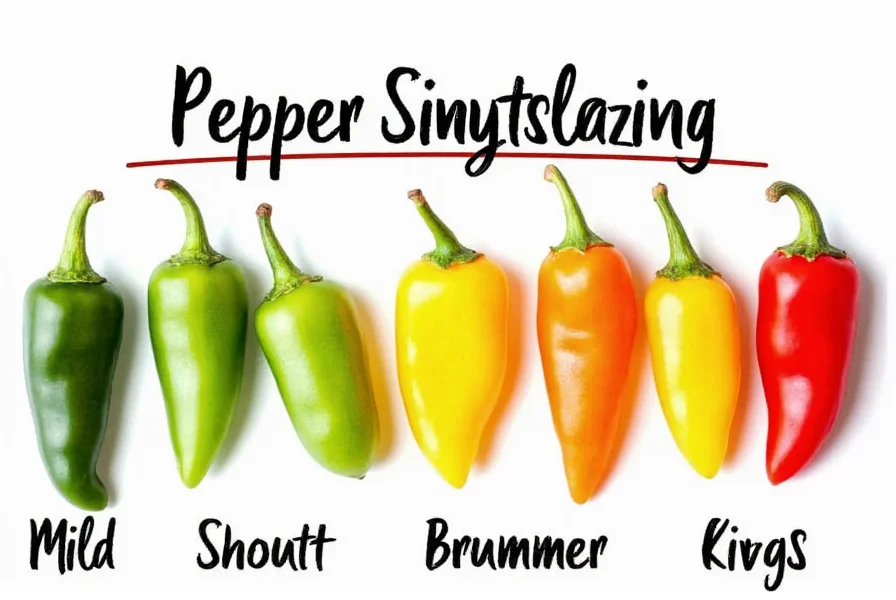The Scoville scale measures the heat level of chili peppers in Scoville Heat Units (SHU), quantifying capsaicin concentration. Developed in 1912 by pharmacist Wilbur Scoville, it originally used human taste testers, but modern methods employ high-performance liquid chromatography (HPLC) for precise measurement. The scale ranges from 0 SHU (bell peppers) to over 2.2 million SHU for the Carolina Reaper, the current world record holder.
Scoville Heat Units (SHU) Chart for Common Peppers
| Pepper Name | Scoville Heat Units (SHU) | Typical Use | Flavor Notes |
|---|---|---|---|
| Bell Pepper | 0 SHU | Salads, stuffing, stir-fries | Sweet, crunchy, mild |
| Poblano | 1,000–2,000 SHU | Mole sauces, chiles rellenos | Earth, mild heat |
| Jalapeño | 2,500–8,000 SHU | Tacos, nachos, poppers | Grassy, slightly smoky |
| Hatch Green Chile | 1,000–8,000 SHU | Enchiladas, sauces | Earthy, smoky, variable |
| Serrano | 10,000–23,000 SHU | Pico de gallo, salsas | Fruity, bright |
| Cayenne | 30,000–50,000 SHU | Spice blends, soups | Earthy, bold |
| Thai Chili | 50,000–100,000 SHU | Curries, Asian dishes | Fruity, sharp heat |
| Habanero | 100,000–350,000 SHU | Hot sauces, marinades | Fruity, floral |
| Scotch Bonnet | 100,000–350,000 SHU | Jamaican jerk, Caribbean cuisine | Fruity, complex heat |
| Ghost Pepper (Bhut Jolokia) | ~1,000,000 SHU | Extreme eating challenges | Burns intensely |
| Carolina Reaper | 1.4–2.2 million SHU | World record holder | Sweet then deadly |

How to Choose the Right Heat Level Safely
Beginners should start with peppers under 10,000 SHU and gradually increase heat tolerance. Always wear gloves when handling hot peppers to avoid skin irritation. For culinary safety:
- Know your limits: If you usually stick to bell peppers, try jalapeños next. They're spicy enough to be exciting without causing severe discomfort.
- Consider the dish: Some dishes need subtlety (like stuffed peppers), while others thrive on heat (like buffalo wings).
- Remove seeds and ribs: Most capsaicin concentrates in the white ribs and seeds. Removing them reduces heat while preserving flavor.
- Pair with dairy: Milk, yogurt, or sour cream neutralize capsaicin. Water spreads it—avoid for cooling relief.
Buying Guide: Selecting Quality Peppers
Best Fresh Peppers
- Jalapeño Packets (Organic): Ideal for beginners. Consistent freshness and flavor for tacos, nachos, and salsas.
- Serrano Pepper Bundle: For intermediate heat seekers. Adds bright, fruity punch to Mexican-style dishes.
- Hatch Chiles (Seasonal): The pride of New Mexico. Smoky and versatile; perfect for roasting and green chile sauce.
Best Pepper Products
- Cayenne Powder (Ground): Essential for controlled heat in rubs, stews, and soups. Small bottle, big impact.
- Habanero Hot Sauce: Fruity, smoky, and fiery. Perfect for drizzling over grilled meats or spicing up Bloody Marys.
- Ghost Pepper Seasoning Blend: Use sparingly for dramatic kick in burgers or fries. Not for the faint-hearted.
Using Peppers in Your Kitchen: Expert Tips
- Roast for balanced heat: Roasting peppers over an open flame brings out natural sweetness and reduces raw bitterness without altering SHU.
- Freeze for longevity: Freeze whole peppers—no thawing needed. Ideal for future use in sauces or stews.
- Infuse oils carefully: Add dried chilies to olive oil for subtle heat. Store in cool, dark places to preserve potency.
- Balance with acid or sugar: Lime juice, vinegar, or honey counteracts intense heat and enhances complexity.
Frequently Asked Questions About Pepper Scoville
What is the Scoville scale?
The Scoville scale measures capsaicin concentration in chili peppers, expressed in Scoville Heat Units (SHU). Developed by Wilbur Scoville in 1912, it quantifies pungency (heat) and remains the global standard for pepper heat measurement.
How is Scoville heat measured today?
Modern measurement uses high-performance liquid chromatography (HPLC), which chemically detects capsaicinoid levels. This method is more accurate than the original human taste test. SHU values are calculated based on capsaicin concentration, ensuring scientific consistency.
What pepper has the highest Scoville rating?
As of 2025, the Carolina Reaper holds the Guinness World Record for the hottest pepper, with a range of 1.4 to 2.2 million SHU. It was developed by Ed Currie of the PuckerButt Pepper Company. While peppers like Pepper X claim higher ratings, they have not been officially verified by Guinness World Records.
Can eating hot peppers be harmful?
Yes, consuming peppers with extremely high SHU (over 1 million) can cause severe gastrointestinal distress, including stomach pain, nausea, and vomiting. In rare cases, it may lead to hospitalization. Medical guidelines recommend starting with lower heat levels and gradually increasing tolerance. Always handle hot peppers with gloves to prevent skin irritation.
Does cooking affect the Scoville rating of peppers?
Cooking does not change the actual capsaicin content (so SHU remains the same), but it can alter heat perception. Roasting brings out sweetness that balances heat, while drying concentrates capsaicin, making peppers seem hotter. Acidic ingredients like tomatoes or vinegar may intensify the heat sensation.
Are hotter peppers healthier?
Capsaicin in hot peppers has anti-inflammatory properties and may boost metabolism, according to research from the National Institutes of Health. However, moderation is key. Excessive consumption of high-SHU peppers can cause gastrointestinal issues. Health benefits are best achieved through moderate, consistent intake—not extreme heat levels.
Conclusion: Spice It Up with Science
Understanding the Scoville scale empowers you to cook safely and confidently. Whether you prefer gentle warmth or extreme heat, knowing pepper heat levels helps you match flavor intensity to your palate and dish requirements. Always prioritize safety: start low, wear gloves, and respect the science behind the burn.










 浙公网安备
33010002000092号
浙公网安备
33010002000092号 浙B2-20120091-4
浙B2-20120091-4